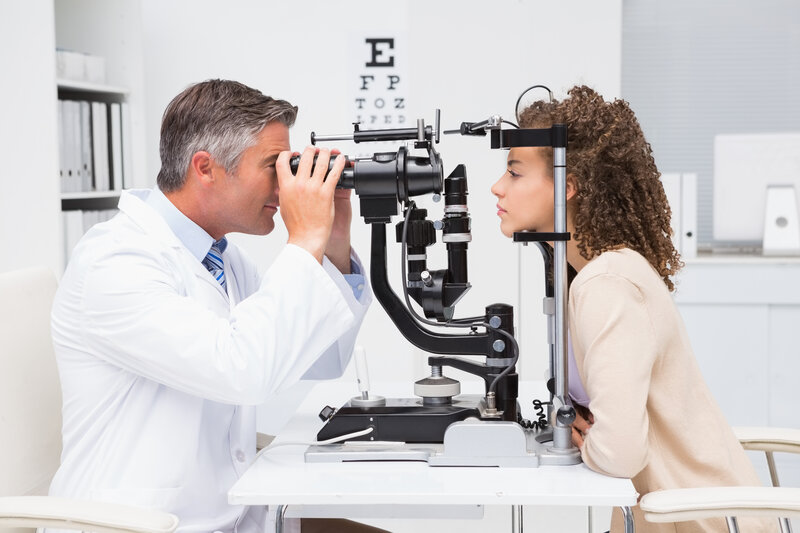Did you know eye exams often provide clues about undiagnosed or unmanaged health conditions? That’s right. They say the eyes are the windows to the soul, but we also feel they are windows into a patient’s medical history.
Your Eye Exam May Detect One Of These Ten Health Issues
So, while we advocate for annual eye exams to optimize eye and vision health, these appointments also serve to keep an eye on several potential health issues. Here are ten health issues that may present via your routine eye exam if you skipped your latest physical.
Whenever we notice signs that something else is amiss, we refer patients to their general physician for an appointment. We are also happy to share any images or findings with their physician or specialist. Partnering with other healthcare providers allows us to create a personalized healthcare plan and improve patient outcomes.
Skin cancers on the eyelid
We think of skin cancers as something found on the trunk of the body or the face. However, many of the most common basal cell carcinomas are found on the eyelids. This is one reason we’re not fans of tanning beds and consistently advise patients to wear UV-blocking sunglasses and hats when spending time outdoors. Those are your best protection against sun-related skin cancers.
In some cases, optometrists have been the first to raise a red flag about leukemia or lymphoma, two cancers that can also affect the internal appearance of the eyes.
Diabetes
Usually, patients experience symptoms of type 2 diabetes before they develop diabetic retinopathy – but not always. Occasionally, we have patients that show signs of diabetic retinopathy before they’ve been diagnosed with type 2 by a physician. In these cases, we pick up on the yellow fluid, and sometimes blood, we notice leaking out of the retina’s tiny blood vessels.
Brain tumor
Sometimes brain tumors develop but don’t present any symptoms until they reach a specific size. This may mean putting pressure on the optic nerve. If that is the case, an optometrist observes swelling toward the back of the eye. Usually, patients with a brain tumor affecting the optic nerve also report changes in their vision, headaches, and fatigue – but not always.
Giant cell arteritis
Patients with giant cell arteritis (GCA) typically schedule an eye exam due to increasingly blurred vision or seeing double. In rare cases, a patient may even experience sudden vision loss in one of their eyes. This is because GCA affects the arteries in the arms, neck, and upper shoulders. The widespread inflammation of the arteries in these areas affects blood flow. Catching the disease early via an eye exam prevents permanent vision loss and even early death.
High blood pressure
Roughly 33% of adults in the United States have high blood pressure, and many don’t know it. Because high blood pressure causes unusual bends, kinks, or bleeding from smaller blood vessels in the rear of the eye, optometrists may know you have HBP before you do. We can test your blood pressure in our office and provide you with lifestyle recommendations to naturally bring your blood pressure down.
High cholesterol
Remember what we said about the body being connected? Well, high cholesterol is another health condition we can detect in one of two ways. First, people with high cholesterol – especially those 40 years old or younger – often have a yellow or blue ring around their cornea. Also, high cholesterol can leave deposits in the blood vessels feeding the retina. We take these symptoms very seriously. They indicate untreated, chronic high cholesterol that puts patients at risk for a stroke.
Certain autoimmune disorders
The eyes also show signs of certain autoimmune disorders. For example, patients with lupus frequently experience dry eyes, and eye tissue may be inflamed. Patients with rheumatoid arthritis have a higher risk of scleritis, which causes red and painful eyes. Myasthenia gravitas also reveals itself during eye exams via droopy eyelids or double vision resulting from muscle weakness.
Health issues like sexually transmitted diseases
Many of the most common sexually transmitted diseases take their toll on eye tissues if they aren’t diagnosed or effectively treated. These include syphilis, herpes, chlamydia, HIV, gonorrhea, and genital warts. Pubic lice can also affect the eyes because they can migrate to the eyelashes, causing eyelid inflammation (blepharitis).
Thyroid issues
A hyperactive (overactive) thyroid causes the eyes to bulge. This makes the eyelids retract back from the eyes, exposing more whites than normal. People with hyperthyroidism, often caused by Grave’s disease, may also experience dry eye, blurred vision, or vision loss.
Lyme disease
Lyme disease is devastating – especially when considering its high rates of under- and misdiagnosis. Patients often have Lyme disease for years or decades without proper treatment. However, optometrists may be the first ones to put all the symptoms and signs together, especially if we notice swelling in the optic nerve without another cause or a patient’s report of seeing floaters – which commonly occurs during the early onset of Lyme disease.
Another Great Reason To Schedule Your Next Eye Exam
Are you one of those people who puts routine physicals and eye exams on the back burner? Annual wellness visits – including eye checkups – are essential for the early detection and treatment of health issues that can cause big problems.
Schedule your next appointment with Atlantic Eye Institute. We’re here to support the overall health and well-being of your eyes and your body. We’ll let you know if we see any signs of these or other red flags of health issues an eye exam can detect and then facilitate communication with your healthcare provider.

